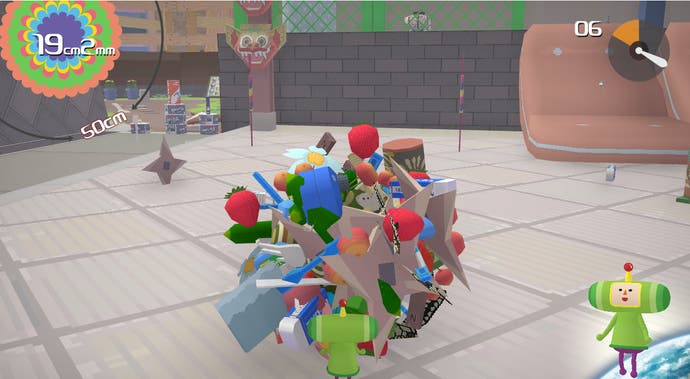The joy of Katamari Damacy
Cosmic.
Katamari Damacy is a special sort of game. So special in fact, that it sidetracked me from writing this several times, playing the game in an absent-minded daze, marvelling at how ČK,the Kanji for katamari, already looks like a small prince rolling stuff up. It worms itself inside your brain by giving the mundane a unique sort of whimsy.
Whimsy, silliness and fun on first glance seem like something unrestrained and purposefully difficult to capture, but Katamari's game director Keita Takahashi made these feelings into substantial pillars of the design philosophy that informs all of his games. Katamari is meant to convey novelty, ease of understanding, enjoyment, and humour, all in a neat little package.
At first glance, there doesn't seem to be much to Katamari Damacy. You and your katamari (Japanese for "clump") are dropped on a random map where you then roll over items to add them to your little ball. What items? Any items. The absence of restrictions is very freeing - if you see something on screen, odds are you can roll it up at some point. The few limitations that do exist make sense: you can't roll into something bigger than yourself, that would ruin the whole equilibrium of your ball. If you bump into any obstacle full force, items are inevitably going to break off of your katamari. Maybe it's an odd core idea for a game, but the mechanics and aesthetic aspects of Katamari are the equivalent of a gentle shrug, the very essence of "why not". Roll with it.

Mechanically, Katamari's joy stems from a mixture of ridiculousness paired with addictive simplicity. I dare you to tell me you didn't giggle with delight at the realisation that you could simply roll up a mouse. Rolling over the mouse that pushed you around when your katamari was still small feels like sweet, sweet revenge, even when the time difference between being hunted and becoming hunter is only about a minute. It's the fulfilment of a power fantasy that requires no violence at all. Well, unless you take into account that you will definitely give the mouse vertigo.
Of course the challenge grows with each level, but so does the satisfaction at your accomplishment. Rolling up bigger and bigger assortments of things within steadily shorter timeframes is no small feat. Like many Japanese games, such as Monster Hunter or most rhythm games, Katamari Damacy requires a certain mastery. You have to be proficient with the controls and in some cases study the layout of the map for a bit to beat a level. Once done, there's still the thrill of exceeding your own achievement or taking on friends. Katamari has you chasing high scores the way you do in some of the most enduring games. Like Tetris, there is often a combination of skill and luck at play when it comes to finding that last piece that gives your ball the required size.
Yet most of the motivation comes from how you receive encouragement much more frequently than punishment. You're not told to hurry, all items you pick up are equally valid to build your clump with. The consequences of bumping into something are never catastrophic. The King of all Cosmos often reacts enthusiastically to your efforts and the nature of the things you roll up, which is understandable, given I'm generally just as overjoyed whenever I find a spare pound between the couch cushions. The wrath of your father the king is severe, but easily soothed by success. The knowledge that it was his drunken debauchery that nearly caused the collapse of the entire cosmos in the first place makes it difficult to take him seriously in his anger. This way, the king is a quintessential dad - a stern, occasionally threatening force on one hand, the guy who falls asleep with his mouth open at a rerun of "I'm a celebrity" on the other. (I'm absolutely not drawing on personal experience here.)

Narratively, Katamari could make a dire point about the dangers of consumerism and the fact that there really is quite a lot of stuff on earth, but as with every other aspect, it's lenient and careful not to hamper your enjoyment. There is a joy in collecting, after all, preserved all the way from collecting shells from the beach, shiny buttons or stickers as children. Why not virtual thumbtacks and cucumbers?
Nothing about Katamari Damacy would work quite as well, however, if it weren't for its laid-back visual aesthetic. With his background in art, Keita Takahashi isn't so much interested in games as he is in playfulness. You can immediately see influences like Taro Okamoto or Yayoi Kusama in the way he uses colours and shapes.
The appeal, purpose or goal of any game he has worked on aren't easily described in an elevator pitch of one sentence. Rolling things up may not sound all that interesting at first, but it's only one aspect of Katamari's charm. The colourful design, the amazing music and the way your katamari will always eventually turn so pleasantly round are all part of what makes the game so fascinating.
By not taking itself too seriously, Katamari allows you to do something that may not serve a distinct purpose. It invites you to look at something visually pleasing and hum a happy tune, to unite what by all accounts shouldn't be united into a satisfying shape. Takahashi's games are different to us because we already have an idea in our minds of how games work, how fun is facilitated and how you maximise engagement. Takahashi found his own answers to all of these questions and instead drew on ideas that are equally familiar to his players from other aspects of life.
Katamari Damacy is designed to appear mostly unconcerned with design, at least the right kind of design. Instead, it's something that simply feels good, and that feeling never goes out of style.
Katamari Damacy Reroll, a remaster of the original game, is now available on PC and Switch.

